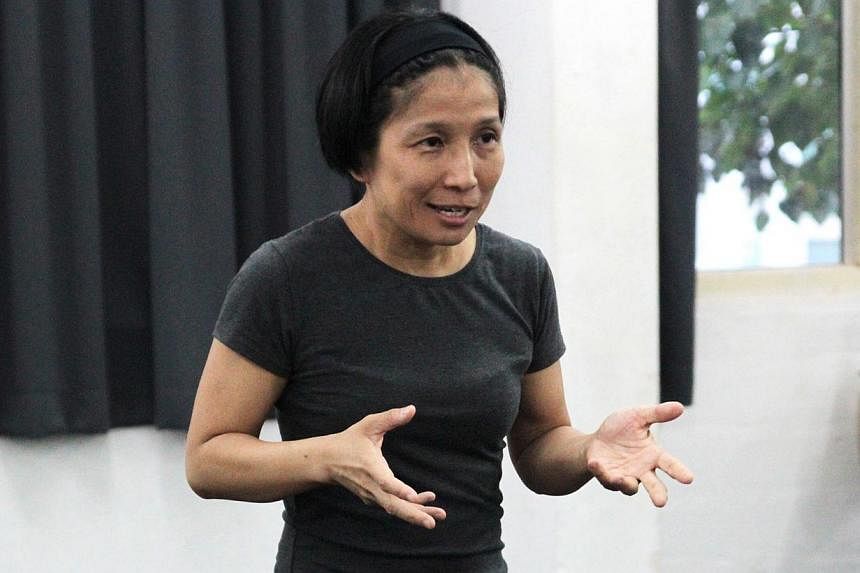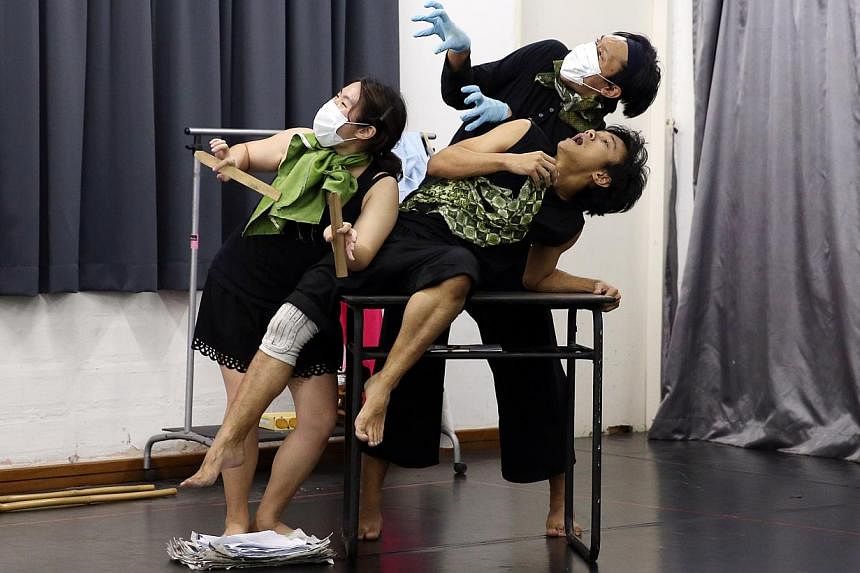Theatre students Al-Matin Yatim, 26, from Singapore, and Chang Ting Wei, 27, from Taiwan, have already started doing their warm-ups on the rehearsal-room floor, trading an easy, familiar banter. Their classmate, Singaporean actor Yazid Jalil, 27, is running late - or is he?
As it turns out, he is perfectly on time in this carefully choreographed first scene of the theatre production Q: Protagonists At The Edge. It is a fascinating play within a play starring the three graduating students from the Intercultural Theatre Institute. They are directed by itinerant Singapore theatre practitioner Ang Gey Pin, 49.
Q draws from two plays by Kuo Pao Kun: The Silly Little Girl And The Funny Old Tree and The Eagle And The Cat; and Three Families Blessings by Lim Jen Erh, originally a traditional Hokkien opera. The experimental production will run from May 27 to 30 at the Esplanade Rehearsal Studio.
Ang was the titular Silly Little Girl when the landmark play - which introduced more experimental, physical theatre techniques to Singapore practitioners - was first staged in Mandarin in 1987. She is currently a PhD candidate in drama at the University of Kent in Britain, where she is exploring movement, music and song. She spent many years in Italy as part of the iconic Workcenter of Jerzy Grotowski and Thomas Richards, pioneers in 20th-century theatre theory and research.
But while the pint-sized artist has spent the greater part of the past 20 years abroad, she is constantly drawn back by the call of home.
For the current production, the works by Kuo and Lim are "a bridge", Ang emphasises: "We're only passing over, we're not stopping there. Maybe, along the way, we might lose something - or maybe we'll discover something new."
The performers channel the characters within these plays, framed within the larger context of three actors trying to put on a play and struggling to understand what Singapore theatre means. They might slip into the long draping sleeves typical of traditional Chinese opera and attempt to speak Mandarin; or perhaps they might rap in Malay and Singlish. Pulling from metaphors and images in the scripts, they crumple into a pile of tree roots, or break into an interpretive dance as honey bees. They might even pour the audience a cup of tea.
Yazid says: "We were told many times to 'be ourselves', to be actors rehearsing a play. And it was really difficult, because who is 'ourselves'? We don't know. Because when we're rehearsing, we're not ourselves. We're actors in a working space... it raises a lot of questions about identity."
Ang sees something compelling in this younger generation of practitioners, who had only just been born even as Kuo was creating some of his seminal works. He later founded the Intercultural Theatre Institute in 2000 (formerly the Theatre Training & Research Programme). Ang wanted to juxtapose the students' personal reactions as actors to the work with the original texts.
She says that her own recollections of Kuo's work were coloured by the unreliability of her own memory: "I was very surprised that when I looked at the video, my memories were different. You remember only certain fragments. You recall some things, but you just don't have the whole picture."
Through improvisations and rehearsals with the cast, she has stitched some of these fragments into a playful whole in a piece that relies a great deal on arresting visuals, movement and sound - even the cadences of different languages being spoken at once.
Al-Matin says of this: "It feels like she came with a bag of jigsaw puzzle pieces and laid them on the floor, and it was up to us to choose them and give them back to her, and then it was up to her how she was going to paint a picture and piece it together."
And even if audience members may have no knowledge of the plays she is using as source material, Ang feels that they will still be able to connect with these other elements.
She says that she is looking for happy accidents, spontaneous moments of play: "Each week I had with them, we had much more to discover... Even if we make a little mess, it's okay."
Follow Corrie Tan on Twitter @Corrietan



